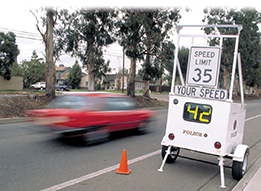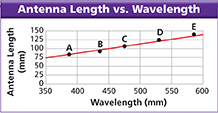Data Analysis
How Long Does an Antenna Need to Be?
Have you ever noticed how the lengths of antennas vary from quite short (cell phones) to very long (radio transmitters)? The length of an antenna depends in part on the length of the waves it transmits. Each letter in the graph (A—E) represents an antenna of a different length. The graph shows the wavelengths that can be transmitted by antennas of a few different lengths.
Calculating What is the frequency of the wave that antenna B transmits? (Hint: Assume the wave travels at the speed of light.)
Drawing Conclusions What relationship is there between antenna length and wavelength?
Inferring At an outdoor concert, a singer is using a wireless microphone with antenna C. Speakers broadcast her performance. Now and then the speakers also broadcast an employee taking an order at a fast food restaurant nearby. What is the approximate wavelength of the transmissions from the restaurant? How do you know?
Predicting If you used a microphone that transmitted waves at 600 MHz, approximately how long would its antenna need to be?
Microwaves
The shortest-wavelength radio waves are called microwaves. Microwaves have wavelengths from about 1 meter to about 1 millimeter. Their frequencies vary from about 300 megahertz to about 300,000 megahertz.
Microwaves cook and reheat food. When water or fat molecules in the food absorb microwaves, the thermal energy of these molecules increases. But microwaves generally penetrate foods only a few centimeters, so heating occurs only near the surface of the food. That is why instructions tell you to let the food stand for a few minutes— so thermal energy can reach the center by conduction. Microwaves also carry cell phone conversations. The process works much like the radio broadcast.
Radar
The word radar is an acronym for radio detection and ranging. Radar technology uses a radio transmitter to send out short bursts of radio waves. The waves reflect off the objects they encounter, and bounce back toward where they came from. The returning waves are then picked up and interpreted by a radio receiver.
Recall that the Doppler effect is an apparent change in the frequency of a wave. The Doppler effect can be used to find the speed of a moving car. Radio waves are sent from a stationary source, such as the radar trailer in Figure 11, toward a moving car. The faster a car is moving toward the source, the higher is the frequency of the radio waves returning to the source.
Figure 11 A speed-monitoring trailer uses radar to measure the speed of an approaching car. It reminds motorists of the posted speed limit and makes them aware of their actual speed.






